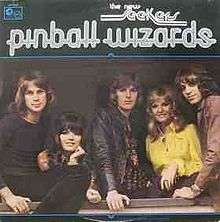Now (The New Seekers album)
Now is a 1973 album by British pop group the New Seekers. It was retitled Pinball Wizards in the US.
| Now | ||||
|---|---|---|---|---|
 | ||||
| Studio album by | ||||
| Released | March 1973 | |||
| Genre | Pop, MOR | |||
| Label | Polydor | |||
| Producer | Michael Lloyd, David Mackay | |||
| The New Seekers chronology | ||||
| ||||
| Alternative cover | ||||
 Pinball Wizards - US version of Now | ||||
Overview
Released in March 1973, the album coincided with the release of their latest hit single "Pinball Wizard/See Me Feel Me", which reached #16 in the UK.[1] This single was a medley of two songs taken from the Who's rock opera Tommy and employed a harder-edged sound for the group with heavy use of electric guitars and sung in a rockier style. The Who's Pete Townshend congratulated the group on their version of the song.[2] No other singles were issued from the album however. Now reached #47 in the UK album charts.[3] The New Musical Express reviewed the album on its release and while criticising the group for their middle of the road nature, it did go on to state: "Nobody denies their natural vocal ability, and I'll go so far as to say the harmonies are excellent".[4]
This was to be the group's last album for a year and was the last album to feature member Peter Doyle who left the group in mid 1973 to be replaced by Peter Oliver.[5]
In the US, the album was released under the title Pinball Wizards with alternate artwork and a slightly different track listing. The title track single had become one of the group's biggest hits there, peaking at #29. This would also be the group's final single to chart. The album itself reached #190.[6]
Track listing (UK)
Side One
- "Pinball Wizard/See Me Feel Me" (Pete Townshend)
- "A Brand New Song" (Jeff Barry, Paul Williams)
- "Look Look" (Marty Kristian)
- "That's My Guy" (Merrill Osmond, Alan Osmond)
- "Feeling" (P. Yellowstone, J. Schwartz)
- "Utah" (Merrill Osmond)
Side Two
- "Reaching Out for Someone" (Dick Holler)
- "Everything Changing" (W. Cates, P. Caldwell)
- "Time Limit" (Kristian, Peter Doyle)
- "Rain" (José Feliciano, H. Feliciano)
- "Somebody Somewhere" (Cook, Greenaway, Rae)
- "Goin' Back" (Gerry Goffin, Carole King)
Track listing (US)
Side One
- "Pinball Wizard/See Me Feel Me" (3.27)
- "A Brand New Song" (2.56)
- "Look Look" (2.54)
- "That's My Guy" (3.10)
- "Feelin'" (3.14)
- "Utah" (2.16)
Side Two
- "Reaching Out for Someone" (2.59)
- "With Everything Changing" (3.24)
- "Time Limit" (3.03)
- "Somebody Somewhere" (2.20)
- "The Further We Reach Out" (Paul Cartledge, Frank Fields, Ken Ashby) (3.23)
Personnel
- Michael Lloyd - Producer
- David Mackay - Producer on "Look Look", "Everything Changing", "Rain", "Somebody Somewhere", "Goin' Back"
- Tommy Oliver - Arranger
- Marty Kristian - Vocals, lead vocals on "Pinball Wizard/See Me Feel Me", "Look Look", "Time Limit"
- Peter Doyle - Vocals, lead vocals on "Pinball Wizard/See Me Feel Me", "Utah", "Goin' Back", "The Further We Reach Out"[7]
- Eve Graham - Vocals, lead vocals on "That's My Guy", "Reaching Out for Someone"
- Lyn Paul - Vocals, lead vocals on "Everything Changing"
- Paul Layton - Vocals
References
- Official Charts - "Pinball Wizard - See Me Feel Me" UK singles chart
- Lyn Paul Website - "Pinball Wizard - See Me Feel Me"
- Official Charts - Now UK chart details
- Lyn Paul website - Now album review
- Official site - Now album details
- Official site - US version details
- http://www.peterdoylewebsite.net/songs/songinfof.htm "The Further We Reach Out" info